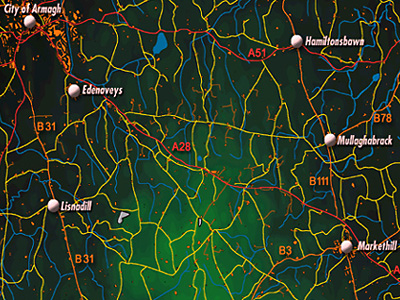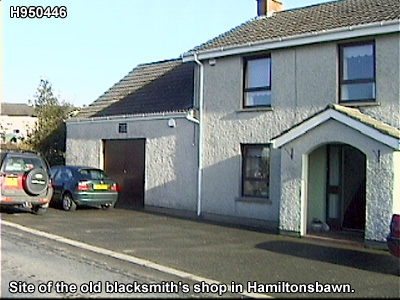
Hamiltonsbawn lies 7.2 km east of Armagh on the A51 and 5.2 km north of Markethill on the B111. It is in the townland of Hamiltonbawn.
"It is a long extablished linear village with the older part fronting the main street and recent development extending mostly northwards along the Annareagh Road. It has an estimated population of 320." (Armagh Area Plan 2004: Armagh District Council Area)
Beside the village is the site of the original bawn, described in a tourist information notice board there:
"This field was the site of Hamilton's Bawn, a fortified house with defended courtyard built by John Hamilton in 1619. By 1622 the lime and stone walls of this structure were 12 feet high and 90 feet long by 63 feet broad. Twenty families resided here during the Plantation period and provided a local garrison of 30 armed men."Hamilton's Bawn was almost totally destroyed during a local uprising in 1641 and rebuilt as a substantial 'Castle' with 3 chimneys by Hans Hamilton. This gentleman sold the property in 1704 to repay his father's debts and by the 1720s the Gosford family of Markethill had taken possession. The Bawn became an army barracks around 1730 after much debate concerning its use, as recorded by Jonathan Swift.
"This Hamilton's Bawn, while it sticks in my hand,
I lose by the house what I get by the land
But how to dispose of it to the best bidder
For a Barrack or Malt-house we must now consider"The 'Old Barracks" was garrisoned by troops of dragoons armed with two hundered muskets until the 1830s. In this role Hamilton's Bawn witnessed numerous important events including the housing of 125 French prisoners force-marched from Kinsale in 1798."
The village was described in 1838 in the Ordnance Survey Memoirs:
The village was described in the Parliamentary Gazetteer:
McKay, P A Dictionary of Ulster Place-names (Belfast, 1999) notes:
Parish of Mullabrack, Barony of Fews Lower
Hamiltonsbawn takes its name from a Bawn or fortified mansion built in 1619 by John Hamilton of East Lothian in Scotland and destroyed in the 1641 rebellion. John Hamilton was of that family of Hamiltons who acquired extensive lands in north Down at the beginning of the seventeenth century and a descendent of whom founded Newtownhamilton in 1770.
(Hamilton's Bawn, 1681)







I (AM, 2013) interpret the dotted circular figure in Bodley's map as the site of a fort or defensive position important in 1609 and most probably the site of the early christian rath noted in the EHS records at grid reference H94834480.
In the accompanying audio recording, Frank McWhirter of Drumbeecross talks about family connections with Hamiltonsbawn (2mins 22s).

Use the audio controller to listen to this talk, given in 2013.